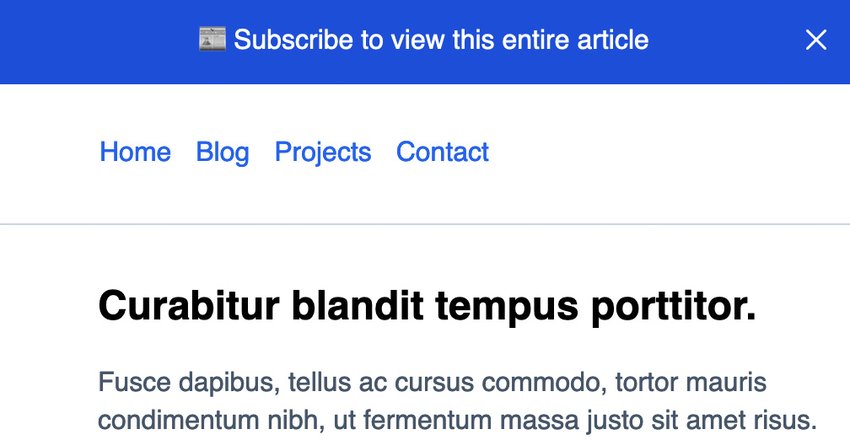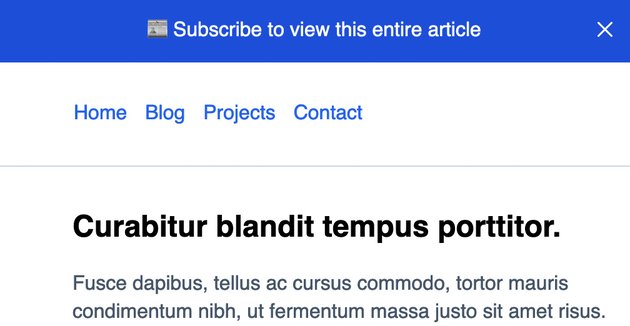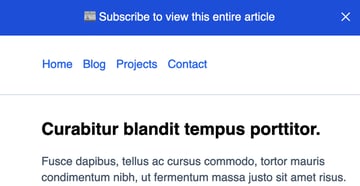[ad_1]
Sadly, all the time displaying an alert takes up much-needed display screen actual property. We are able to resolve this by making it dismissible. Right this moment, we’ll construct one from scratch utilizing localStorage and JavaScript.
What We’re Creating
The instance on this case is a primitive portfolio-like web site with a footer, navigation, and content material space. On the high of the viewport, we show an alert prompting the customer to subscribe. In a fictitious world, the web site we mockup up might need premium content material solely out there to subscribers.
See how our alert works within the pen beneath; although when you’ve dismissed it you’ll not be capable of see it on this browser, so there’s a screenshot beneath to remind you:



1. Add the Markup
On the high of the web page, I’ll add the alert HTML markup. The code is positioned after the physique tag in your HTML doc.
<html>
<physique>
<div class="alert" function="alert">
? Subscribe to view this complete article
<button>
<svg
xmlns="https://www.w3.org/2000/svg"
width="24"
peak="24"
viewBox="0 0 24 24"
>
<title>shut</title>
<g fill="none">
<path
stroke="#ffffff"
stroke-linecap="spherical"
stroke-linejoin="spherical"
stroke-width="1.5"
d="M17.25 6.75l-10.5 10.5"
></path>
<path
stroke="#ffffff"
stroke-linecap="spherical"
stroke-linejoin="spherical"
stroke-width="1.5"
d="M6.75 6.75l10.5 10.5"
></path>
</g>
</svg>
</button>
</div>
</physique>
</html>The alert is a div with a function="alert" possibility which tells the browser and accessibility options that the content material is supposed to sign to the end-user.
We added a button ingredient that’s wrapping an SVG icon I copied from heroicons, an open-sourced icon library. The button ingredient will probably be accountable for triggering the dismissal of the alert when clicked, and we’ll add the logic to make that work developing.
Demo Content material
Under the alert, we’ll add some placeholder content material to imitate the portfolio web site.
<header class="header">
<nav aria-label="Primary">
<ul>
<li><a href="https://webdesign.tutsplus.com/tutorials/#">Dwelling</a></li>
<li><a href="https://webdesign.tutsplus.com/tutorials/#">Weblog</a></li>
<li><a href="https://webdesign.tutsplus.com/tutorials/#">Initiatives</a></li>
<li><a href="https://webdesign.tutsplus.com/tutorials/#">Contact</a></li>
</ul>
</nav>
</header>
<major class="major">
<h2>Curabitur blandit tempus porttitor.</h2>
<p>Lorem ipsum.....</p>
<div class="callout">
<a href="https://webdesign.tutsplus.com/tutorials/#">Register</a> or <a href="https://webdesign.tutsplus.com/tutorials/#">enroll</a> to view this text.
</div>
</major>
<footer class="footer">
<nav aria-label="Primary">
<ul>
<li><a href="https://webdesign.tutsplus.com/tutorials/#">Dwelling</a></li>
<li><a href="https://webdesign.tutsplus.com/tutorials/#">Weblog</a></li>
<li><a href="https://webdesign.tutsplus.com/tutorials/#">Initiatives</a></li>
<li><a href="https://webdesign.tutsplus.com/tutorials/#">Contact</a></li>
</ul>
</nav>
</footer>We render shared navigation inside each the header and the footer blocks. Every nav has an aria-label="Primary" attribute to suggest they’re the identical controls in two places.
The major ingredient comprises placeholder content material and a div ingredient with the callout class. The callout is an upsell for web site guests to see the content material on the web page.
2. Styling the Web page
To maintain issues theme-able, I’ll leverage CSS variables on this information so you’ll be able to tweak colours in your finish.
The alert types observe the variables.
:root {
--primary: #2563eb;
--bg-light: #f1f5f9;
--bg-alert: #1d4ed8;
--bg-callout: #dbeafe;
--border-base: #cbd5e1;
--text-base: #475569;
}
.alert {
background: var(--bg-alert);
padding: 1rem;
text-align: middle;
colour: white;
place: relative;
rework: scaleY(1);
transition: all ease-in-out 0.3s;
}
.alert button {
border: none;
background: clear;
width: 32px;
peak: 32px;
border-radius: 50%;
show: flex;
align-items: middle;
justify-content: middle;
cursor: pointer;
place: absolute;
high: 8px;
proper: 5px;
}
.alert button:hover {
background: rgba(255, 255, 255, 0.35);
}
.alert-hidden {
opacity: 0;
padding: 0;
visibility: hidden;
rework: scaleY(0);
transform-origin: high;
transition: all ease-in-out 0.3s;
}
.alert button:focus {
box-shadow: inset 0 0 0 2px var(--border-base);
}The .alert button ingredient is completely positioned contained in the .alert div. Our button fixes the button to the correct aspect of the alert and offsets from the highest barely.
Neater Hiding of the Alert
You could discover a rework property on the .alert class. And the identical rework property on the alert-hidden class. We’ll be toggling the alert-hidden class with JavaScript developing. The rework property mixed with transition offers us a extra performant technique to present and conceal the alert with some good animation. Utilizing the scaleY(0) method, we will regularly toggle the looks.
It’s price noting that we may toggle look with a show property however doing that with JavaScript leaves no room for any animations must you need to have these.
Further Kinds
Listed here are some extra types to handle the opposite parts of the web page. For probably the most half, they’re elementary. The callout container has some properties set to make it stand out greater than the remainder of the content material on the web page.
.header {
border-bottom: 1px strong var(--border-base);
}
.header,
.footer {
padding: 1rem;
}
.footer {
background: var(--bg-light);
padding: 1rem;
}
.header ul li,
.footer ul li {
show: inline;
padding: 0 5px;
}
.major {
max-width: 767px;
padding: 1rem;
margin-left: 2.75rem;
margin-bottom: 2rem;
}
.callout {
background: var(--bg-callout);
padding: 2rem;
border-radius: 6px;
}
p {
colour: var(--text-base);
line-height: 1.4;
}
ul {
list-style: none;
}
a {
colour: var(--primary);
text-decoration: none;
}3. Dismissing the Alert
With JavaScript, we will hook into the browser’s Occasion API to pay attention for adjustments. A typical occasion used is the “click on” occasion.
Earlier than we will pay attention for the occasion, we have to inform JavaScript concerning the ingredient it must search for within the DOM.
-
An
alertvariable: accountable for concentrating on the alert itself. -
A
dismissAlertButtonvariable: accountable for concentrating on thebuttoningredient inside the.alertdiv.
const alert = doc.querySelector(".alert")
const dismissAlertButton = doc.querySelector(".alert button")Subsequent, we have to pay attention for the “click on” occasion talked about earlier than, so we all know when to dismiss the alert. We are able to do this utilizing the addEventListener() technique on the button.
dismissAlertButton.addEventListener("click on", (occasion) => {
console.log("Clicked!")
})We are able to use the useful console.log() utility to check issues out. The button ought to log Clicked! to your browser’s console.
4. Stopping Default Logic
For any use of the addEventListener technique, we get a free occasion of the occasion object itself to be used inside the tactic. That is essential for circumstances the place you would possibly have to overwrite browser defaults. It’s sometimes a good suggestion to stop the default logic of a component you’re concentrating on with JavaScript.
dismissAlertButton.addEventListener("click on", (occasion) => {
occasion.preventDefault()
})Subsequent, we should always toggle the visibility of the alert. We are able to do that in a few methods, however as talked about within the CSS part, we’ll leverage a extra animated method.
if (dismissAlertButton) {
dismissAlertButton.addEventListener("click on", (occasion) => {
occasion.preventDefault()
alert.classList.add("alert-hidden")
})
}Right here we add the alert-hidden class, which successfully fades the alert out of sight when clicking the button. It really works!
You could discover I added some conditional logic to test that the dismissAlertButton is just not null. If there occurred to be a web page with out the button, our JavaScript would render an error. To repair this problem, you’ll be able to add a conditional test to make sure the ingredient is on the web page. A easy if assertion ought to get the job executed.
5. Saving Native State
Sadly, the alert exhibits once more while you reload the web page after clicking the dismiss button. We are able to tackle this with one thing referred to as localStorage, constructed into trendy browsers.
localStorage means that you can save a little bit of browser information quickly. It’s not meant as a real datastore like a database however works equally.
We’ll leverage localStorage to set a brand new key and worth pair within the browser. Then we will test if that worth is ready earlier than displaying the alert.
The API is comparatively easy. In the long run, right here’s the ultimate code.
const alert = doc.querySelector(".alert")
const dismissAlertButton = doc.querySelector(".alert button")
if (localStorage.getItem("hideAlert")) {
alert.type.show = "none"
}
if (dismissAlertButton) {
dismissAlertButton.addEventListener("click on", (occasion) => {
occasion.preventDefault()
alert.classList.add("alert-hidden")
localStorage.setItem("hideAlert", true)
})
}Right here’s what’s occurring:
- We’ll test if the dismiss button is current and if that’s the case, pay attention for a click on occasion on it.
- If the clicking occasion fires, we add the
alert-hiddenclass to the alert. - With
localStorage, we name thesetItemtechnique and move in a key-value pair ofhideAlertandtrue. - If the web page had been to reload, we instantly hook into “localStorage” once more to name the
getItemtechnique concentrating on the identical key and worth pair set beforehand and conceal the alert with CSS by way of JavaScript.
Some Limitations
localStorage is a wonderful resolution for easy issues. As you’re employed via my instance, you might discover a slight flicker as a browser masses once more, and localStorage values are set.
That is one downside to the method, because the HTML and CSS typically load earlier than executing the JavaScript. The one method round it is a server-side rendered resolution the place the code is dynamic relative to an precise database-backed worth.
Closing Ideas
Dismissible components are an effective way to seize consideration and clear up much-needed display screen actual property. Your web site’s guests admire the power to dismiss one thing, even when it’s useful to know!
[ad_2]











